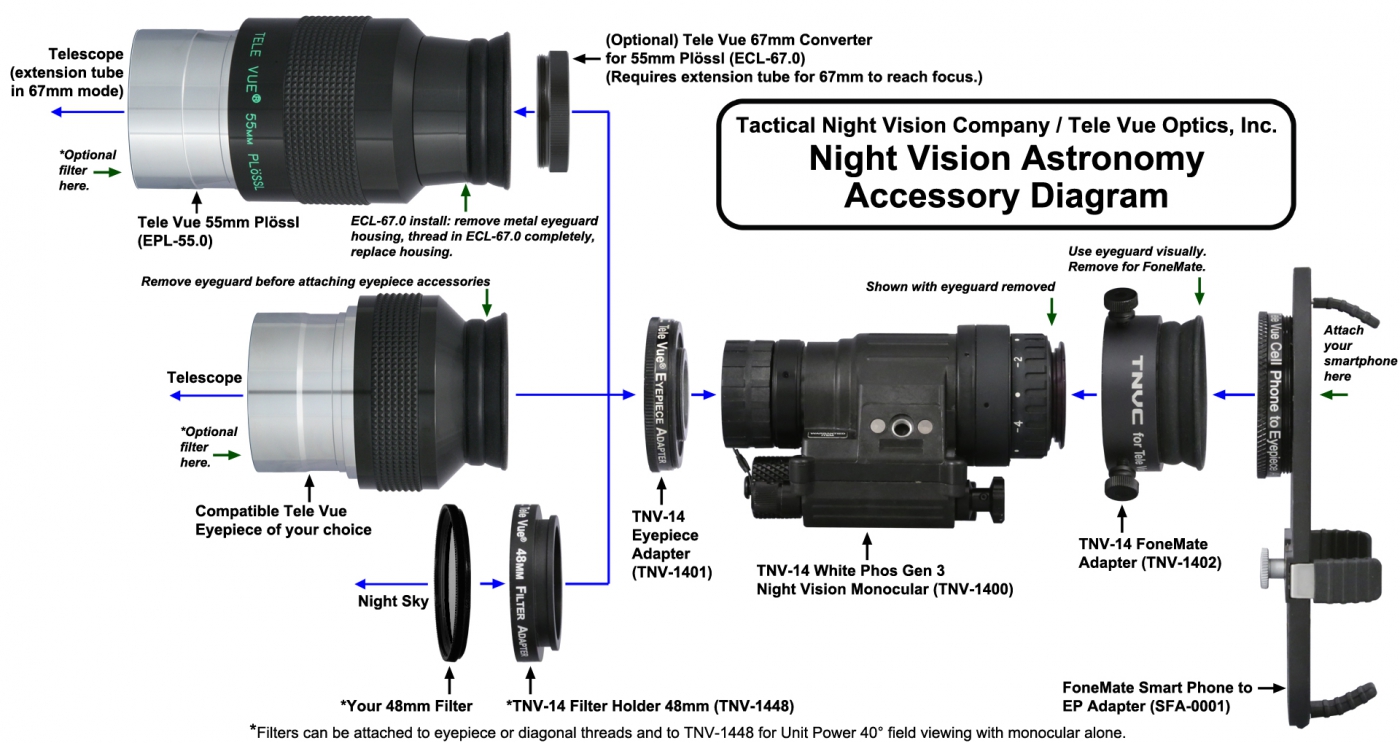Night Vision Astronomy from Bortle 9 & 4 Skies!
This week we feature the stories of two amateur astronomers delving into night vision astronomy: one from a built-up urban location and one under rural/suburban skies.
The Lights of Chicago
In the past, amateur astronomers located in and near large cities had to content themselves with planetary, lunar, and solar observations from their backyards and balconies. That all changed with the introduction of electronic-assisted astronomy and narrow-band astrophotography. For real-time nebula and faint galaxy viewing, night vision devices (NVD) have come to the forefront. Amateur Darren Drake tells us that with night vision he is able to view such targets as the Horsehead nebula from his “horrendous Chicagoland Bortle 9 backyard.” He sent us some images and described his viewing and imaging techniques using the Tactical Night Vision Company’s PVS-14 L3 Gen3 Un-Filmed White Phosphor (mobile site) monocular with our Tele Vue accessories.

All of Darren’s images on this blog were produced through two big Dobsonian scopes: either his 18″ f/4.42 or John Pratte’s 32″ f/3.6. The astronomical targets determined the eyepiece and filter combinations used on the Dobs. “The larger emission nebulae are always done with a wide field, low power, Tele Vue 55mm Plossl with Tele Vue 67mm Converter and hydrogen-α filter. The other images, such as the Ring Nebula are with a 17mm Stratus eyepiece with no filter. All star clusters are usually with no filter as well.”


Darren’s afocal imaging through the night vision device is done with a Samsung Galaxy S21 phone in “night mode.” This mode turns off the flash and takes deeper exposures. Darren simply handholds the phone over the eyepiece and takes several images. The best are then slightly enhanced. “It’s really quite simple and has immediate results.” Darren emphasizes that “the images are close to what is seen in real-time through the NVD.”


How does the view compare to using the scopes without the TNVC PVS-14 we asked? “Since the sensitivity is higher in the red, red objects and stars are dramatically more brightened than white or blue objects. This is clearly seen when constellations become completely unrecognizable due to the red stars jumping out of nowhere to dominate star fields. This is also why hydrogen-α targets are so amazingly enhanced since they are red.” Darren’s impression is that the TNVC PVS-14 on the eyepiece empowers the scope to act as if it has a 2.5x larger mirror. That’s like being able to see a star 6x dimmer!
Night Vision in Rural Virginia

Corey Dallmeyer (aka: Telescope Boss on social media) is working with night vision under Bortle 4 rural/suburban skies in Virginia. His Gen 3 PVS-14 night vision monocular uses an L3 brand of filmless white phosphor tube. He employs it on an Orion SkyQuest XX16G GoTo Dobsonian using a combination of Tele Vue night vision eyepiece adapter, Tele Vue 55 Plössl with 67mm converter, Tele Vue 35mm Panoptic, or several other eyepieces. Filters include Hydrogen-α or 685 nm IR filter for nebulas. He also has the filter adapter that allows for contrasty views of the night sky just using the PVS-14 hand-held.
His Instagram, YouTube and telescopeboss.com website are PVS-14 resources for amateur astronomers with equipment reviews, dark sky sites, imaging tips, night vision advice, DIY projects, and more. The Everything I Use for Night Vision Astronomy article on the site is an excellent resource for those starting out in night vision astronomy.
Corey’s imaging “recipe” is as follows: on globulars or galaxies use no filter or 685 nm IR filter; on extended or planetary nebulae use a Hydrogen-α filter.
Following is his short 1-minute crazy nebula with night vision video made with the 16″ Dob, 35mm Pan, Hydrogen-α, and handheld Samsung Galaxy A71 smartphone. It contains a gallery of nebula images made with night vision.
Telescope Boss: crazy nebula with night vision YouTube video.
This second video, good focus, clean night vision phone pics!!, also from Corey’s YouTube channel uses the same hardware but substitutes (mostly) the 55mm Plössl with 67mm Converter.
One of the latest articles on telescopeboss.com is H Alpha Filters For Night Vision Astronomy: 6 Filters Compared. It’s a comparison of Eagle Nebula images made with Hydrogen-α filters connected to a camera lens and Gen 3 night vision device using a Huawei P30 Pro smartphone. Exposures were 30-sec at ISO 400. The review included six filters. A sampling of three is shown here in a gallery. In the gallery, Hydrogen-α filter bandwidth narrows going left to right (12nm, 6.5nm, and 3nm). While the 12nm may seem the “best”, those viewing from heavily light-polluted skies will do better with the narrower band filters.

Did you observe, sketch, or image with Tele Vue gear? We’ll like your social media post on that if you tag it #televue and the gear used. Example:
#televue #tv85 #ethos #pvs14 #m8
Do you want your Tele Vue images re-posted on Tele Vue Optics’ Social Media accounts? Use this hashtag for consideration:
More Info
- Night Vision: “How To” Video Shorts with TNVC PVS-14 and Tele Vue Adapters
- Night Vision in the UK: Seize the Night! blog post features NV images with and without scope
- TNVC Night Vision Direct from Tele Vue blog post
- TNVC / Tele Vue Night Vision and Accessories on Tele Vue website (mobile site)














Well done a great blog. Its great that Televue are helping to keep visual observers, observing as light pollution gets worse.
NV like eye to eyepiece allows the same capabilities as normal viewing. Apart from planetary and double stars.
The NV system allows observing just like any other method of visual observing. It’s not imaging nor is it EAA. The new generation of paper white tubes provide a natural view in the eyepiece.
Thanks for keep astronomy viable in light polluted areas.